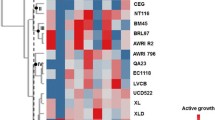Abstract
The improvement of yeast starters for wine making, with classical genetic techniques, relays on the effective independence of the main oenological traits in order to combine them optimally. The analysis of three characters (ethanol production, volatile acidity and fermenting rate) in 787Saccharomyces cerevisiae strains, isolated from several parts of the world and substrates, shows moderate correlation between the volatile acidity and the other two traits, whereas ethanol production and fermenting rate appear more correlated. The minimum number of strains necessary to start selection or genetic improvement programs is discussed. The correlation between the oenological traits and the source of isolation showed that the best strains can be obtained from wineries and wine, whereas the isolates from grapes and must are less performing on the average.
Similar content being viewed by others
References
Castelli T. (1948). Gli agenti della fermentazione vinaria in diverse regioni italiane. Riv. Viticol. Enol., 8: 1–7.
Castelli T. (1964). Indagini microbiologiche sui mosti maltesi. Vini d’Italia, VI: 189–191.
Castelli T., Georgantas S. (1970). Gli agenti della fermentazione vinaria nel nord della Grecia. Vini d’ Italia, XII: 185–191.
Ciani M., Rosini G. (1987). Definizione dell’indice di moltiplicazione della CO2 nella valutazione, per via ponderale, della capacità alcoligena di un lievito. Ann. Fac. Agr. Univ. Perugia, XLI: 753–762.
Corte L., Lattanzi M., Buzzini P., Fatichenti F., Cardinali G. (2005). Use of RAPD and killer toxin sensitivity inSaccharomyces cerevisiae strain typing. J. Appl. Microbiol., 99: 609–617.
Fleet G.H., Prakitchaiwattana C.J., Heard G.M. (2002). The yeast ecology of wine grapes. Research Signpost, 37: 1–17.
Legendre P., Legendre L. (1998). Numerical Ecology, 2nd English edn, Elsevier Science B.V.
Maifreni M., Comi G., Rondinini G. (1999). Selection and oenological characterisation ofSaccharomyces cerevisiae strains isolated from Tocai, Pinot and Malvasia grapes and musts of the Collio area. Ann. Microbiol., 49: 33–43.
Martini A. (1993). Origin and domestication of the wine yeastSaccharomyces cerevisiae. J. Wine Res., 4: 165–176.
Martini A., Ciani M. (1996). Preliminary evidence for a local microevolution of specific selected starters for wine-making on winery surfaces. 9th Int. Symp. Yeasts, Sydney, Australia, p. 78.
Marullo P., Bely M., Masneuf I., Aigle M., Dubourdieu D. (2004). Inheritable nature of enological quantitative traits is demonstrated by segregating technological properties of industrial wine yeast strains. FEMS Yeast Res., 4: 711–719.
Miklos I., Sipiczki M., Benko Z. (1994). Osmotolerant yeasts isolated from Tokaj wines. J. Basic Microbiol., 34: 379–385.
Minárik E. (1965). Ecology of natural species of wine yeasts in Czechoslovakia. Mikrobiologija, 2: 29–37.
Mora J., Barbas J.I., Ramis B., Mulet A. (1988). Yeast microflora associated with some Majorcan must and wines. Am. J. Enol. Vitic., 39: 344–346.
Mortimer R.K., Romano P., Suzzi G., Polsinelli M. (1994). Genome renewal: a new phenomenon revealed from a genetic study of 43 strains ofSaccharomyces cerevisiae derived from natural fermentation of grape musts. Yeast, 10: 1543–1552.
Parle J.N., Di Menna M. (1965). The source of yeasts in New Zealand wines. N. Zealand J. Agr. Res., 9: 98–107.
Pretorius I.S. (2000). Tailoring wine yeast for the new millennium: novel approaches to the ancient art of winemaking. Yeast, 16: 675–729.
Ramirez M., Regodon J.A., Perez F., Rebollo J.E. (1999). Wine yeast fermentation vigor may be improved by elimination of recessive growth-retarding alleles. Biotechnol. Bioeng., 65: 212–218.
Rainieri S., Pretorius I.S. (2000). Selection and improvement of wine yeasts. Ann. Microbiol., 50: 15–31.
Romano P., Soli M.G., Suzzi G., Grazia L., Zambonelli C. (1985). Improvement of a wineSaccharomyces cerevisiae strain by a breeding program. Appl. Environ. Microbiol., 50: 1064–1067.
Rosini G. (1983). The origin ofSaccharomyces cerevisiae in winemaking. IX Int. Spec. Symp. on Yeasts, Smolenice, Czechoslowakia, pp. 18–22.
Rosini G., Federici F., Martini A. (1979). Revisione tassonomica e tecnologica della Collezione dei lieviti vinari dell’Istituto di Microbiologia Agraria e Tecnica dell’Università di Perugia. Nota I: Considerazioni e revisione della specieSaccharomyces rosei Guilliermond. Vini d’Italia, 21: 207–213.
Sipiczki M., Romano P., Lipani G., Miklos I., Antunovics Z. (2001). Analysis of yeasts derived from natural fermentation in a Tokaj winery. Antonie van Leeuwenhoek, 79: 97–105.
Vaughan-Martini A., Martini A. (1995). Facts, myths and legends on the prime industrial microorganism. J. Indust. Microbiol., 14: 514–522.
Vilanova M., Massneuf-Pomarede I. (2005). Characterization of yeast strains from Rías Baixas (NW Spain) and their contribution to the fermentation of Albariño wine, Ann. Microbiol., 55: 23–26.
Volschenk H.V.M., Grobler J., Petzold B., Bauer F., Subden R.E., Young R.A., Lonvaud A., Denayrolles M., van Vuuren H.J. (1997). Engineering pathways for malate degradation inSaccharomyces cerevisiae. Nat. Biotechnol., 15: 253–257.
Zimmerman D.W., Zumbo B.D., Williams R.H. (2003). Bias in estimation and hypothesis testing of correlation. Psicológica, 24: 133–158.
Author information
Authors and Affiliations
Corresponding author
Rights and permissions
About this article
Cite this article
Corte, L., Rellini, P., Sciascia, F. et al. Distribution and correlation of three oenological traits inSaccharomyces cerevisiae . Ann. Microbiol. 56, 19–23 (2006). https://doi.org/10.1007/BF03174964
Received:
Accepted:
Issue Date:
DOI: https://doi.org/10.1007/BF03174964




